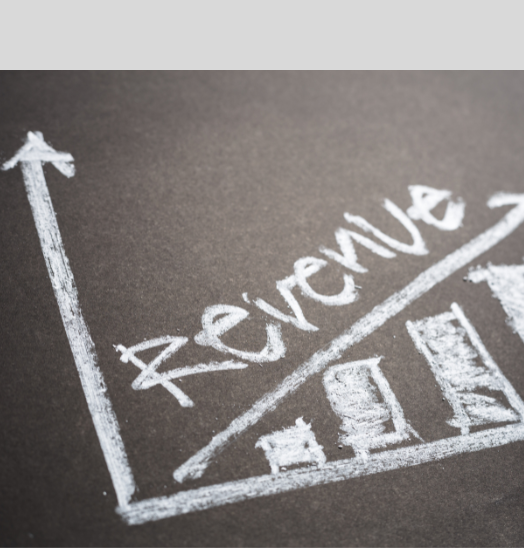I hope you enjoy reading this blog post.
If you want to get more traffic, Contact Us

Click Here - Free 30-Minute Strategy Session
Be quick! FREE spots are almost gone for this Month. Free Quote

Revenue and profit are fundamental concepts in financial management and business operations. Revenue, often referred to as the “top line”, represents the total income a company generates from its core activities, such as sales of goods or services. It is an essential metric for assessing business performance and market demand.
Profit, on the other hand, is the “bottom line”, calculated by deducting all expenses, including operational costs, taxes, and interest, from the revenue. It provides insight into a company’s financial health and efficiency.

Click Here – Free 30-Minute Strategy Session
Be quick! FREE spots are almost gone for this Month
Understanding the relationship between revenue and profit is crucial to making informed financial decisions and ensuring sustainable growth.
Revenue refers to the total income generated by a business from its core operational activities, typically through the sale of goods or services. It is often considered the top line of an income statement, reflecting the gross inflow of funds before deducting any expenses. Revenue serves as a key indicator of a company’s financial performance and growth potential.
There are two primary types of revenue:
Understanding these types aids in accurate financial assessments.
Understanding profit involves dissecting its key components: gross, operating, and net profit.
Each type serves distinct roles in evaluating financial performance and decision-making.
Revenue and profit are interconnected financial metrics essential for evaluating a business’s health. Revenue, often described as the top line, represents the total earnings from sales of goods or services before any expenses are deducted. Profit, also referred to as the bottom line, showcases the amount left after covering costs, including production, operations, and taxes.
The relationship between the two is critical. Strong revenue provides the opportunity for higher profit, but inefficient cost management can erode profitability. Businesses must balance revenue growth with cost control to optimise profitability. Careful analysis ensures strategic decisions align with long-term success.
Understanding the distinction between revenue and profit is essential for making informed financial decisions. Revenue, often called the “top line,” represents the total income generated from sales of goods or services. On the other hand, profit, the “bottom line,” refers to what remains after deducting all expenses, taxes, and costs from the revenue.
Failing to differentiate these concepts can lead to misguided financial strategies. For instance:
Therefore, recognising this difference helps businesses assess financial health accurately and avoid common misconceptions.
Many individuals and businesses unintentionally confuse revenue and profit, leading to flawed financial understanding. Several common misconceptions contribute to this confusion:
Understanding these points is critical to making informed financial decisions.
For sustainable business growth, it is essential to track metrics that provide insights into financial performance. Revenue and profit, while interconnected, serve distinct purposes in decision-making.
Monitoring revenue growth helps assess customer acquisition or sales strategies. However, a focus on profit reveals whether those revenue streams translate into value creation. Maintaining a balance between these ensures long-term success.
Maximising profit while boosting revenue involves balancing costs, pricing, and scalability. Key strategies include:
Sustaining profit growth requires maintaining a balance between revenue expansion and operational efficiency.
Expenses significantly influence an organisation’s revenue and profit, serving as a key determinant of financial outcomes. Costs can be divided into two primary categories: fixed and variable. Fixed expenses, such as rent or salaries, remain constant regardless of sales performance, while variable expenses, like raw materials or shipping costs, fluctuate with production volume.
Managing expenses efficiently can boost profit margins even without increasing revenue. Poor expense control, on the other hand, can erode profits despite healthy revenue streams. Businesses often analyse cost structures to identify inefficiencies and optimise investments. Striking the right balance between necessary expenditures and prudent cost-saving measures is critical for sustaining profitability.
Taxation significantly influences both revenue and profit, affecting how businesses allocate resources and plan financially. Taxes directly reduce a firm’s overall revenue through obligations such as sales tax, VAT, and excise duties, limiting the income available before operating costs are considered. Corporate taxes also impose a direct burden on profit, as they are deducted from earnings after expenses, further narrowing the net profit margin.
Businesses often adjust pricing strategies to offset tax implications, which can, in turn, impact customer demand. Additionally, tax incentives or credits may help minimise burdens, influencing long-term profit projections. Understanding taxation’s role is essential for sustainable financial planning.
Understanding revenue and profit differences becomes clearer with real-world examples. Consider a technology start-up generating £500,000 in annual revenue. While the top-line figure appears impressive, operating costs, including salaries, software licensing, and marketing, total £450,000. This leaves a profit of just £50,000, emphasising that high revenue doesn’t always translate to substantial profit.
In another scenario, a boutique bakery earns £200,000 in revenue but manages costs efficiently, spending £120,000 on rent, ingredients, and wages. Its £80,000 profit highlights that smaller businesses can sometimes achieve higher profit margins through prudent expense management.
These cases highlight how evaluating both metrics leads to sharper financial insights.
Choosing the right tools and software is essential for accurate tracking of revenue and profit. These solutions streamline financial management, provide key insights, and enhance decision-making capabilities.
Each tool supports detailed tracking and ensures decision-makers stay informed about financial performance.
Identifying early warning signs in revenue and profit trends is vital for maintaining financial health. A consistent decline in revenue over successive periods indicates potential trouble, possibly stemming from reduced demand or increased competition. Simultaneously, a drop in profit margins despite steady or rising revenue signals efficiency issues, such as escalating operational costs.
Other red flags include irregular cash flow patterns, mounting debt-to-income ratios, and over-reliance on one revenue source or key client. A mismatch between revenue growth and profit generation suggests hidden expenses or flawed pricing strategies. A sudden spike in one-time expenses should also be scrutinised to understand underlying causes, such as legal disputes or mismanagement.
Revenue and profit play pivotal roles in shaping business strategies, guiding leaders in resource allocation and future planning. Revenue serves as a fundamental indicator of business performance, dictating whether a company has the market demand to sustain operations. High revenue often leads to decisions to scale production, expand markets, or invest in marketing efforts.
Profit, conversely, reflects the economic viability of those efforts. Businesses rely on profit margins to evaluate operational efficiency, determine cost-cutting measures, or reinvest in growth. Together, revenue and profit inform decisions on product pricing, workforce expansion, or capital expenditures, balancing growth with sustainability for long-term success.
Understanding the distinction between revenue and profit is essential for sound financial management. Revenue refers to the total income generated from sales or services, while profit represents what remains after expenses are deducted. Misinterpreting the two can lead to flawed decision-making and financial missteps.
Business owners who grasp the difference can:
A clear grasp of both concepts empowers more accurate forecasting and ensures long-term business viability.

LEAVE A REPLY